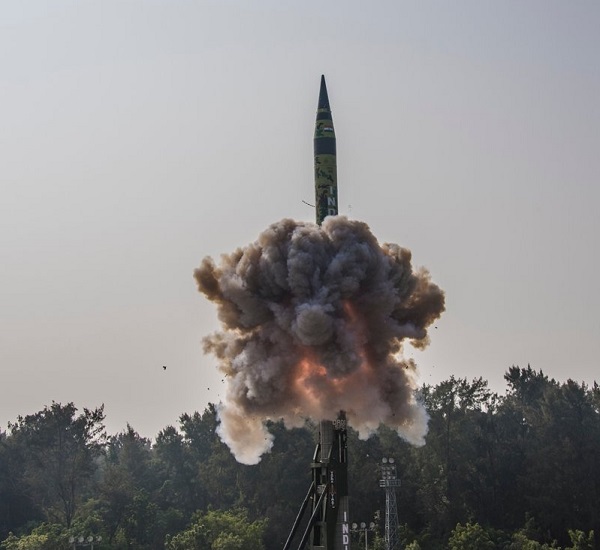New Delhi, (Samajweekly) Nuclear escalation between India and China was not only unlikely but also unthinkable, a Stockholm International Peace Research Institute (SIPRI) report on ‘South Asia’s Nuclear Challenges’, released on Thursday, said.
“Among Chinese and Indian experts, there was a prevailing view that they shared the same stance on no first use, and that nuclear escalation between the two countries was not only unlikely but also unthinkable,” the Swedish think tank’s report said.
Some experts, the SIPRI report said, cited nuances in India’s approach towards no first use and an evolving discussion in the country on its future, while others pointed to some of the past debate in China on no first use. They, however, largely disregarded these caveats when it came to escalation.
In most cases, there was a steadfast view that both countries were on the same page when it came to nuclear posture, with no first use as just one example.
“While stabilising in the context of recent tensions at the China-India border, the assumption that both parties are operating from the same starting point merits greater attention – in relation not just to no first use but also a range of nuclear postures from de-mating to targeting,” the report stated.
Assumptions of “postural parity” may bring stability in the short term, when altercations are largely limited to skirmishes at the border, but in the longer term — as both China and India extend the ranges of their systems and deployments — such assumptions may lead to misunderstandings and mis-signalling.
Further, the continued dominance in Indian analyses of the concept of a “two-front” threat from China and Pakistan means that greater consideration of how deterrence operates among these three countries is needed, even if it requires more countries at the table, it said.
Among Chinese and US experts, there was a strong tendency for experts from each to see the other country as playing a larger and more destabilising role in South Asia.
While much of the commentary from Chinese experts centred on India-Pakistan dynamics, when it came to external influences, the USA’s role was paramount.
While citing past US weapon sales to the region and the 2005 India-US nuclear deal for their role in strengthening India and freeing up its nuclear material for military aims, Chinese experts also focused on forward-looking initiatives such as the US Indo-Pacific Strategy and the Quadrilateral Security Dialogue, which have a focus on China as well as India.
Among US experts, China’s outreach to Pakistan in terms of conventional and nuclear assistance, military training, and more recently, the China- Pakistan Economic Corridor under the Belt and Road Initiative (BRI) demonstrate China’s far-reaching aspirations in the region, the report said.
While Chinese experts characterised China’s role as stabilising, US experts were more cautious in evaluating its long-term implications.
Nonetheless, they cited tensions generated by China’s arms sales to South Asia and economic engagement under the BRI, combined with the most recent incidents along the China-India border, as presenting an opportunity for greater US collaboration with India.
“For this very reason, however, some US experts expressed concern that the region could break into two camps, with the USA and India on one side and China and Pakistan on the other,” the report stated.
This conflicting view of regional dynamics and their own countries’ roles indicates the importance of greater China-US engagement on South Asia.
Among Indian and US experts, there was a shared concern that Chinese entanglement of conventional and nuclear platforms and command and control could filter into Pakistan’s posture and planning.
Despite this commonality, interviews revealed limited avenues for nuclear discussion. In particular, US experts cited the difficulty of engaging Indian interlocutors on nuclear issues, particularly at the official level.
Further, Indian experts expressed scepticism about the US approach to South Asian dynamics, which is built on US scenario-building and tabletop exercises.
A number stated that they did not recognise South Asia within these US assessments, suggesting that there was “an inherent artificiality” in the US approach. There was a tendency to view US assessments as projections that did not reflect India’s reality, as with US discussions of India’s potential shift towards counterforce doctrine.
Nevertheless, a number of Indian experts emphasised a growing willingness within India to move beyond its historical reticence driven by non-alignment and to cultivate more active involvement in such initiatives as the Quadrilateral Security Dialogue and the US Indo-Pacific Strategy and even to propose such concepts as an AI Quad or Digital Quad.
While they noted that this shift in India has been largely shaped by recent events on the India-China border, this willingness to engage suggests that a window may be open in the near term for more high-level India-USA interactions on nuclear issues.
Download and Install ‘Samaj Weekly’ App
https://play.google.com/store/apps/details?id=in.yourhost.samajweekly










